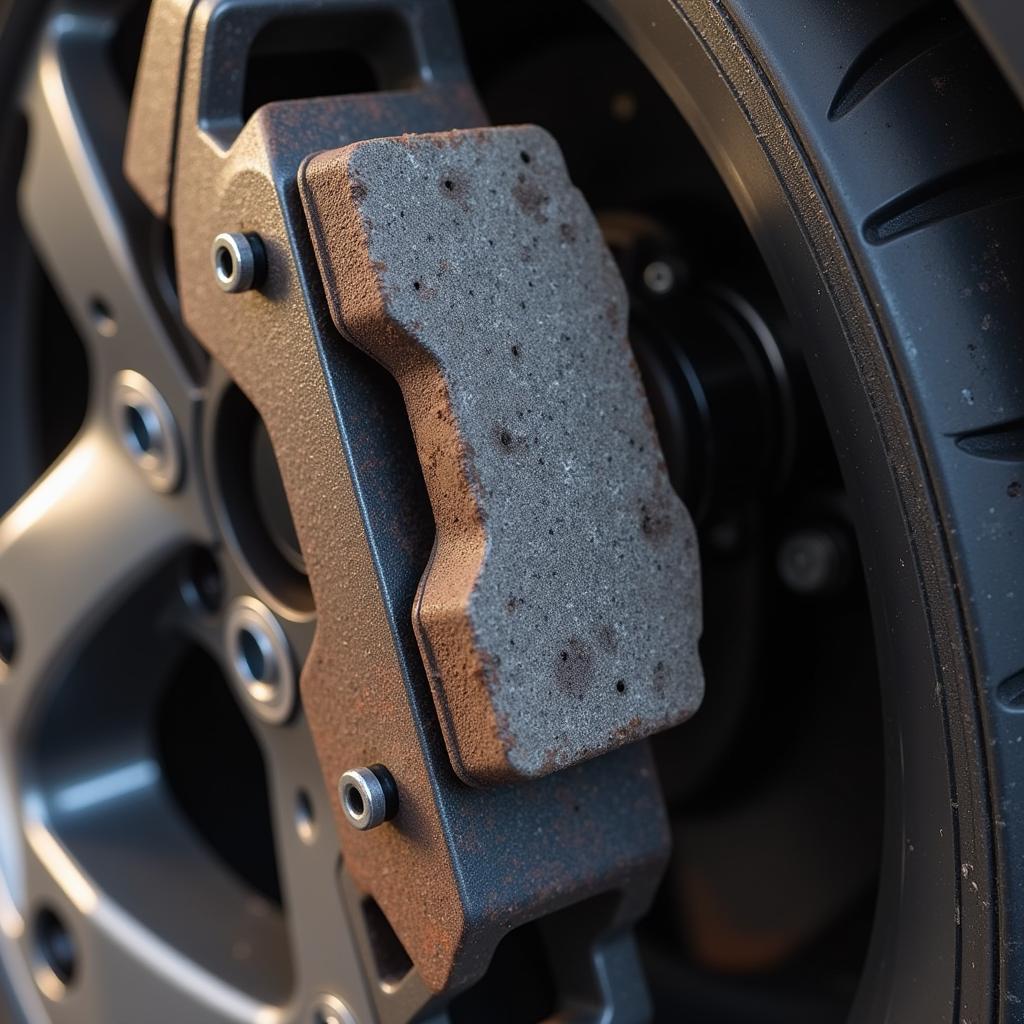The dreaded brake lining warning light on your BMW X5 dashboard. It’s a sight that can strike fear into the heart of any driver. But what does it mean, and how serious is it? This comprehensive guide will walk you through everything you need to know about the BMW X5 brake lining warning, from understanding its causes to exploring your options for a swift resolution.
Deciphering the BMW X5 Brake Lining Warning
The brake lining warning light, often accompanied by an audible chime, signals that your brake pads are nearing the end of their lifespan. This warning system is crucial for maintaining optimal braking performance and ensuring your safety on the road.
Modern BMW X5 models are equipped with wear sensors embedded within the brake pads themselves. These sensors trigger the warning light when the brake pad material wears down to a predetermined level, typically around 2-3 millimeters.
Common Causes of a Brake Lining Warning
While worn brake pads are the primary culprit behind the brake lining warning, several other factors can contribute to this issue:
- Driving Habits: Frequent hard braking, city driving with constant stop-and-go traffic, and towing heavy loads can accelerate brake pad wear.
- Brake Pad Quality: Low-quality brake pads tend to wear down faster than their higher-quality counterparts.
- Environmental Factors: Extreme temperatures, road salt, and debris can impact brake pad longevity.
- Faulty Sensors: While rare, a malfunctioning brake pad wear sensor can trigger a false warning.
 BMW X5 Brake Pad Wear Sensor
BMW X5 Brake Pad Wear Sensor
Addressing the Brake Lining Warning: What to Do
Ignoring the brake lining warning can lead to severe consequences, including compromised braking ability and expensive repairs. Here’s a step-by-step guide on what to do:
-
Confirm the Diagnosis: While worn brake pads are the likely cause, it’s crucial to confirm the diagnosis. This can be done visually by inspecting the brake pads for wear or by consulting a qualified mechanic.
-
Assess the Urgency: If the brake pads are severely worn, you’ll likely experience a noticeable decrease in braking performance. In such cases, it’s crucial to stop driving the vehicle immediately and have it towed to a repair shop.
-
Explore Your Options: For moderately worn brake pads, you have two primary options:
- Brake Pad Replacement: This is the most common and recommended solution. Replacing your brake pads will restore optimal braking performance and ensure your safety.
- Brake Pad Sensor Replacement: If the warning light is triggered by a faulty sensor, replacing the sensor will resolve the issue. However, it’s essential to rule out worn brake pads before opting for this solution.
 Replacing Brake Pads on a BMW X5
Replacing Brake Pads on a BMW X5
DIY vs. Professional Brake Service: Weighing Your Options
While replacing brake pads is a relatively straightforward procedure, it requires a certain level of mechanical expertise and specialized tools. If you’re comfortable working on your vehicle and have the necessary skills, a DIY brake job can save you money on labor costs.
However, if you’re unsure about any aspect of the process, it’s always best to entrust your BMW X5 to a qualified mechanic. They have the knowledge, experience, and equipment to perform the repair safely and efficiently.
“When it comes to brakes, safety should be your top priority,” advises John Smith, a veteran automotive technician with over 20 years of experience. “If you’re unsure about tackling a brake job yourself, don’t hesitate to seek professional assistance.”
Preventing Premature Brake Pad Wear: Proactive Measures
Extending the lifespan of your brake pads not only saves you money but also ensures optimal braking performance. Here are some tips to prevent premature brake pad wear:
- Practice Smooth Braking: Anticipate stops and gradually apply the brakes instead of slamming on them.
- Reduce Unnecessary Cargo: Carrying excessive weight puts additional strain on your brakes.
- Use Engine Braking: When descending steep hills, downshift to a lower gear to utilize engine braking.
- Regular Brake Inspections: Include a visual inspection of your brake pads during routine maintenance checks.
Conclusion
The brake lining warning on your BMW X5 is a crucial safety feature that should never be ignored. By understanding its causes, addressing the issue promptly, and adopting preventative measures, you can ensure optimal braking performance and enjoy peace of mind behind the wheel. Remember, when it comes to your safety and the safety of others on the road, it’s always better to err on the side of caution.
Frequently Asked Questions
Q: How long can I drive with the brake lining warning light on?
A: It’s not advisable to drive with the brake lining warning light on. The urgency depends on the severity of the wear. However, any delay can compromise braking performance and lead to more extensive damage.
Q: Can I replace just the brake pads, or do the rotors need to be replaced too?
A: While it’s possible to replace only the brake pads, it’s generally recommended to have the rotors inspected and resurfaced or replaced if necessary.
Q: How often should I replace my BMW X5’s brake pads?
A: Brake pad lifespan varies depending on driving habits and other factors. However, a general rule of thumb is to have them inspected every 12,000 miles and replaced as needed.
Q: Can I use aftermarket brake pads on my BMW X5?
A: Yes, you can use aftermarket brake pads. However, it’s crucial to choose high-quality pads from reputable brands to ensure optimal performance and compatibility with your BMW X5’s braking system.
Q: How much does it cost to replace brake pads on a BMW X5?
A: The cost of brake pad replacement varies depending on factors like location, labor rates, and the type of brake pads used.
